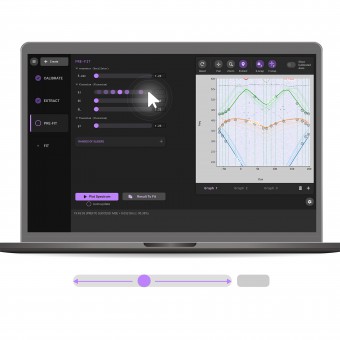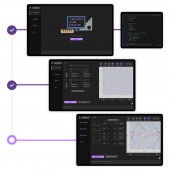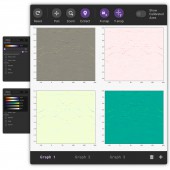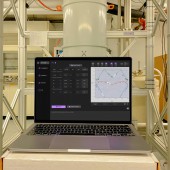QFit Desktop Application by Tianying Lyu |
Home > |
 |
|
||||
| DESIGN DETAILS | |||||
| DESIGN NAME: QFit PRIMARY FUNCTION: Desktop Application INSPIRATION: The advancement of superconducting quantum computing depends on creating scalable and reliable hardware devices. Characterizing properties of these devices is critical but slow, which requires identifying features in experimental data that reveal quantum behavior of the device, and developing a model that matches these features. An integrated tool can significantly streamline this process, saving scientists valuable time, and thereby accelerating development of quantum computing. UNIQUE PROPERTIES / PROJECT DESCRIPTION: QFit seamlessly integrates the entire workflow of device characterization. Users can effortlessly visualize and calibrate data, extract and annotate data features, interactively adjust models for an optimal fit, and refine the model with advanced algorithms. Designed for scientists at all levels, it boasts an intuitive UI and UX, requiring just 30 minutes to master. By saving 90% of the overhead time on setting up the analysis, QFit allows users to focus on the scientific task. OPERATION / FLOW / INTERACTION: QFit is launched through the Jupyter interface, where users first construct a model for their device using scqubits, then provide experimental data and open the app. Users are guided to complete the 4 steps for device characterization: calibration (specify unit conversion between measurement data and model), extraction (pick, group and label features from visualized data), prefit (adjust model parameters via sliders to match features), fit (automated parameter refinement with one click). PROJECT DURATION AND LOCATION: The project starts in 2020 and the most significant progress has been made since July 2023. Team members were worked in Evanston, Illinois, United States. FITS BEST INTO CATEGORY: Interface, Interaction and User Experience Design |
PRODUCTION / REALIZATION TECHNOLOGY: The development of qfit has undergone multiple iterations, guided by insights gained from qualitative user tests. These tests engaged scientists with different levels of expertise in device characterization, ensuring that qfit meets the diverse needs and expectations of its intended users. SPECIFICATIONS / TECHNICAL PROPERTIES: QFit's backend leverages a suite of robust open-source Python libraries including matplotlib (visualization), numpy (data management), scipy and scqubits (scientific computing). The user interface is developed with PySide6 (Qt for Python), ensuring compatibility across all major operating systems (windows, macOS, Linux). TAGS: superconducting quantum computing, device characterization, interactive scientific computing, desktop application RESEARCH ABSTRACT: We conducted qualitative user tests at various stages to gather comprehensive feedback from our target users, scientists, on qfit. Each test was structured with minimal documentation and a typical task, allowing us to observe user interactions closely and conduct subsequent interviews after the experience. The most critical feedback pointed to certain interface designs being unintuitive. Responding to this, we refined our interfaces to ensure they offer clear, effective guidance. CHALLENGE: The main challenge stems from QFit being the first one available in the public, which focuses on device characterization for superconducting quantum computing. This leaves us initially uncertain about what designs do target users prefer in the early development stages. User testing has been crucial, providing us essential feedback that guides our design improvements to align the app with user needs and expectations. ADDED DATE: 2024-02-27 07:25:34 TEAM MEMBERS (4) : Tianying Lyu, Tianpu Zhao, Danyang Chen and Jens Koch IMAGE CREDITS: Image #1: Photographer Tianpu Zhao, QSET Lab, 2024 Image #1: Scientists Chunyang Ding and Helin Zhang, two-tone spectroscopy data, 2023 Image #2: Scientists Chunyang Ding and Helin Zhang, two-tone spectroscopy data, 2023 Image #2: Photographer Artem Podrez, Photo of Blue Parchment Paper with Wrinkles, 2021 Image #3: Scientists Chunyang Ding and Helin Zhang, two-tone spectroscopy data, 2023 Image #3: Creator rawpixel.com / Freepik, Digital device mockup, 2024 Image #3: Photographer Artem Podrez, Photo of Blue Parchment Paper with Wrinkles, 2021 Image #4: Scientists Chunyang Ding and Helin Zhang, two-tone spectroscopy data, 2023 Image #4: Creator rawpixel.com / Freepik, Digital device mockup, 2024 Image #4: Photographer Artem Podrez, Photo of Blue Parchment Paper with Wrinkles, 2021 Image #5: Scientists Chunyang Ding and Helin Zhang, two-tone spectroscopy data, 2023 Image #5: Creator rawpixel.com / Freepik, Digital device mockup, 2024 Image #5: Photographer Artem Podrez, Photo of Blue Parchment Paper with Wrinkles, 2021 Video Credits: Scientists Chunyang Ding and Helin Zhang, two-tone spectroscopy data, 2023 Video Credits: Musician VictorWayne, Technology World, 2022 Video Credits: Creator NaturalReader, video voiceover, 2024 PATENTS/COPYRIGHTS: QFit is an open-source application, licensed under the BSD 3-Clause license. The app will be presented in the APS March Meeting 2024, session A47.5: https://meetings.aps.org/Meeting/MAR24/Session/A47 .5 This work was supported by the AFOSR under grant FA9550-20-1-0271 and in part by the U.S. Department of Energy, Office of Science, National Quantum Information Science Research Centers, Co-design Center for Quantum Advantage (C2QA) under Contract Number DE-SC0012704. |
||||
| Visit the following page to learn more: https://github.com/scqubits/qfit | |||||
| SOCIAL |
| + Add to Likes / Favorites | Send to My Email | Comment | Testimonials |







